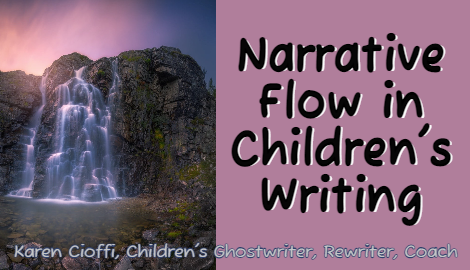Narrative flow is the engine that moves a story steadily forward. It’s the rhythm, pacing, and seamless progression of events that keep children flipping pages, absorbed in the storytelling.
At its core, narrative flow refers to the smooth and cohesive movement of a story from beginning to end. It’s the art of guiding young readers through a sequence of events, emotions, and experiences in a way that feels natural and engaging.
In children’s writing, where the audience’s attention spans are shorter, and their comprehension levels are still developing, mastering narrative flow is essential to creating an engaging and fun reading experience.
So, let’s break down some of the elements that create narrative flow.
- Pacing
One of the key elements of narrative flow in children’s writing is pacing.
Just like a rollercoaster ride, a well-paced story knows when to accelerate with heart-pounding excitement and when to slow down for the young reader to catch up and reflect on what’s going on.
A balance act is needed to create a ‘good’ pace. Moments of action, dialogue, description, and exposition need to be woven together to keep young readers fully engaged while allowing them time to process and absorb the unfolding events.
- Structure and Organization
This narrative flow relies heavily on the structure and organization of the story. A clear beginning, middle, and end provide young readers with a sense of direction and purpose, allowing them to easily follow the story arc.
Within this structure, authors introduce characters, establish settings, and set the stage for the adventures and problems to be overcome that lie ahead. This lays the foundation for a consistent and satisfying story.
- Point of View Consistency
Young children’s books (picture books through simple middle grades) should be written with one point of view, that of the protagonist. In other words, who is telling the story, or whose story is it?
This consistency helps the young reader from becoming disengaged while figuring out who they should cheer for. It also allows the reader to form a connection with the protagonist.
Another element of point of view is whether the story is told in first, second, or third person. Whichever you choose, be consistent.
- Tense Consistency
Tense is another element that needs to remain consistent. Whether you choose simple past or present tense, keep it consistent throughout your story. Interestingly, past tense is used the most in fiction writing.
Accidently changing the point of view or tense within your story can cause the reader to pause or worse yet, become confused.
- Writing Language and Style
In children’s literature, where every word counts, and simplicity is crucial, authors must choose their language carefully to ensure it’s easily understood and engages their young audience.
Vivid imagery, fun language that’s easy to understand, and rhythmic prose not only capture children’s attention but also immerse them in the world of the story. This helps make the reading experience enjoyable and memorable.
- Transitions
Narrative transitions help tie ideas/scenes together. They can indicate a change in time or place and are a big part of the story flow.
Seamless transitions help to bridge the gaps between these changes and keep the momentum going smoothly, preventing young readers from feeling disoriented or confused.
For a list of transitional words and phrases, check out https://www.wlwv.k12.or.us/cms/lib/OR01001812/Centricity/Domain/1843/transitionWordsinNarrativeWriting.pdf
- Language and Style
The language and style of your writing are also crucial in shaping narrative flow. This is especially true in writing for children, where every word counts, and simplicity is a must.
The young reader needs this simplicity in order to become immersed in the story. Language and style can also help the story to be memorable. Age-appropriate words, sentences, and paragraphs matter.
- Balancing Exposition and Action
While exposition provides essential background information and context, action drives the plot forward and keeps readers hooked. Finding the right balance between these elements is vital to maintaining momentum and preventing the story from feeling stagnant or overly dense.
By weaving exposition seamlessly into the narrative and sprinkling it with moments of excitement and intrigue, authors create a dynamic and engaging reading experience that keeps children anticipating what will happen next.
Summing It Up
Narrative flow is the engine that keeps your story moving forward, guiding young readers on amazing adventures and sparking their imaginations. Using story elements, such as pacing, structure, language, and transitions, helps authors create immersive worlds for children to go on journeys of adventure, discovery, and wonder.

I’m a working children’s ghostwriter, rewriter, editor, and coach. I can help turn your story into a book you’ll be proud to be the author of, one that’s publishable and marketable.
OTHER HELP I OFFER:
HOW TO WRITE A CHILDREN’S FICTION BOOK
A DIY book to help you write your own children’s book.
PICTURE BOOK AND CHAPTER BOOK COACHING
Four to ten-week coaching programs.
WRITERS ON THE MOVE PRESS.
Self-publishing help for children’s authors.
You can contact me at: kcioffiventrice@gmail.com. Or give me a call at 347—834—6700. (Please leave a message- I’ll get back to you as soon as I can.)


1 thought on “Narrative Flow in Children’s Writing”